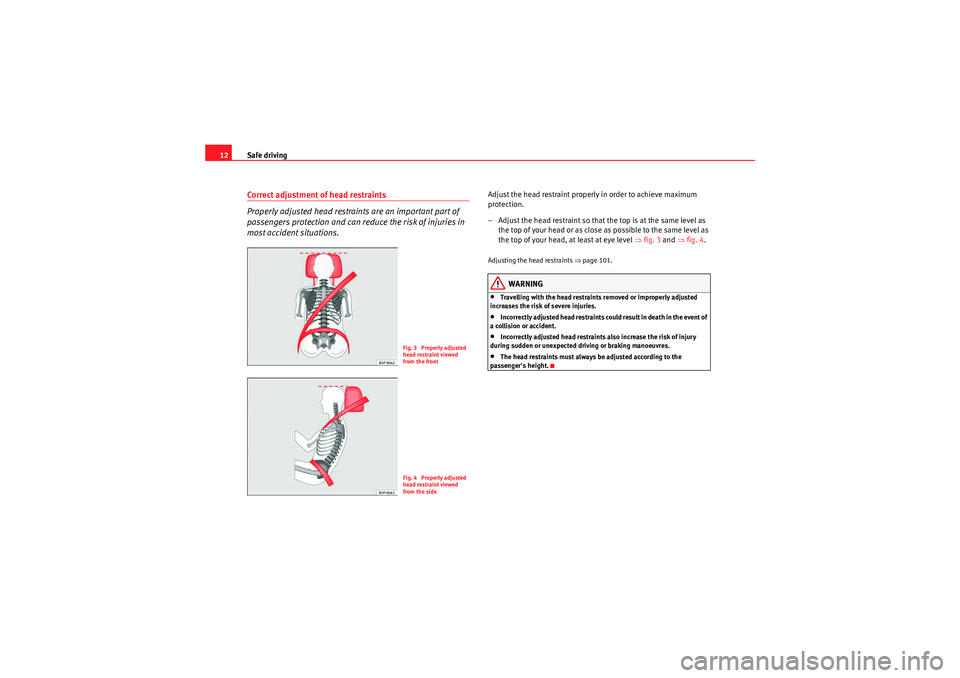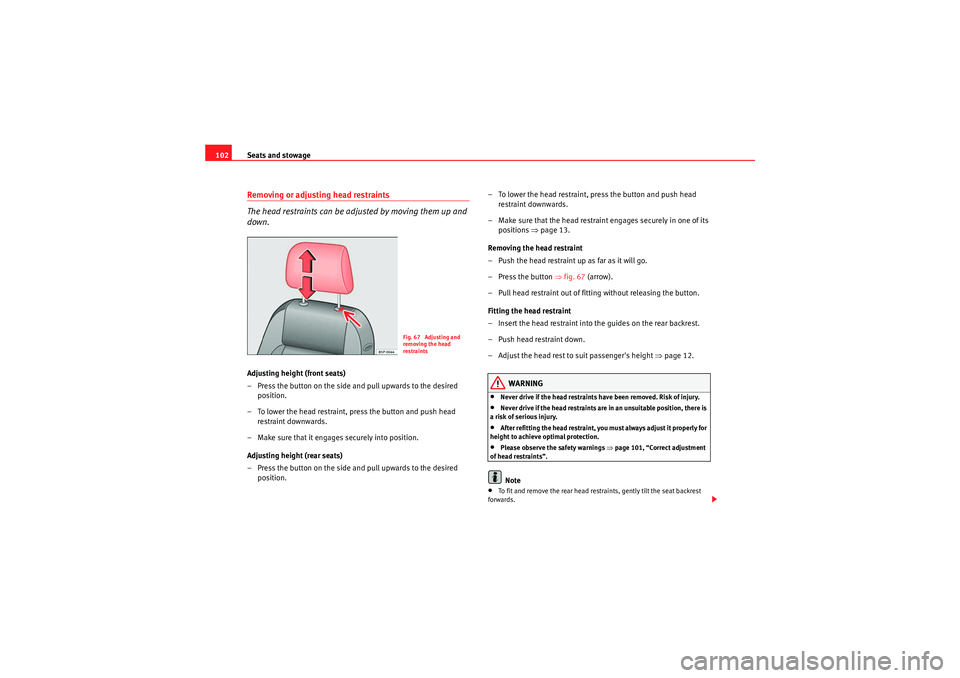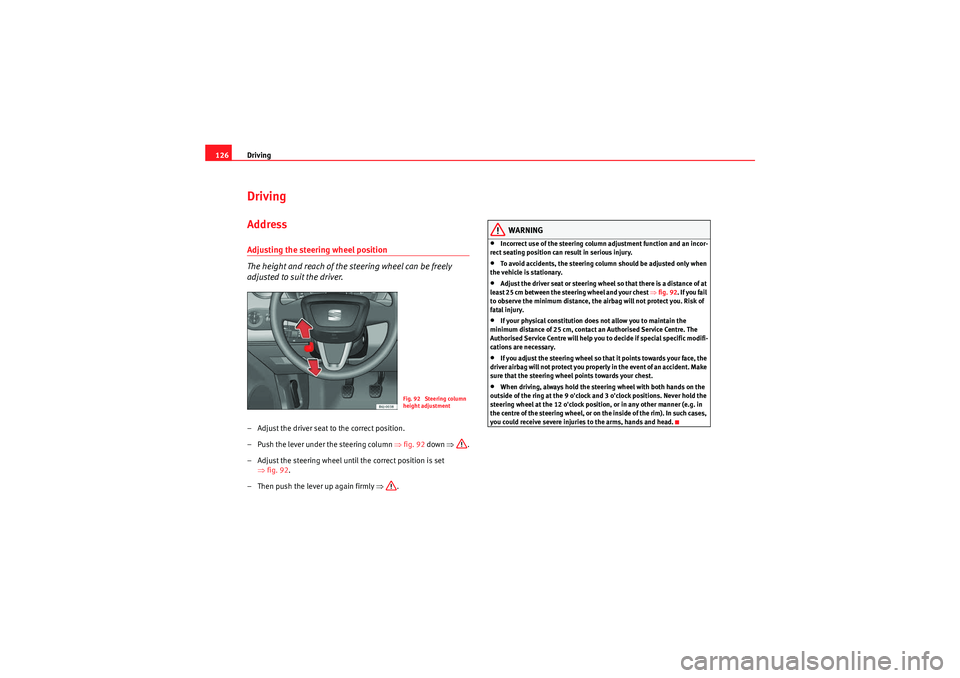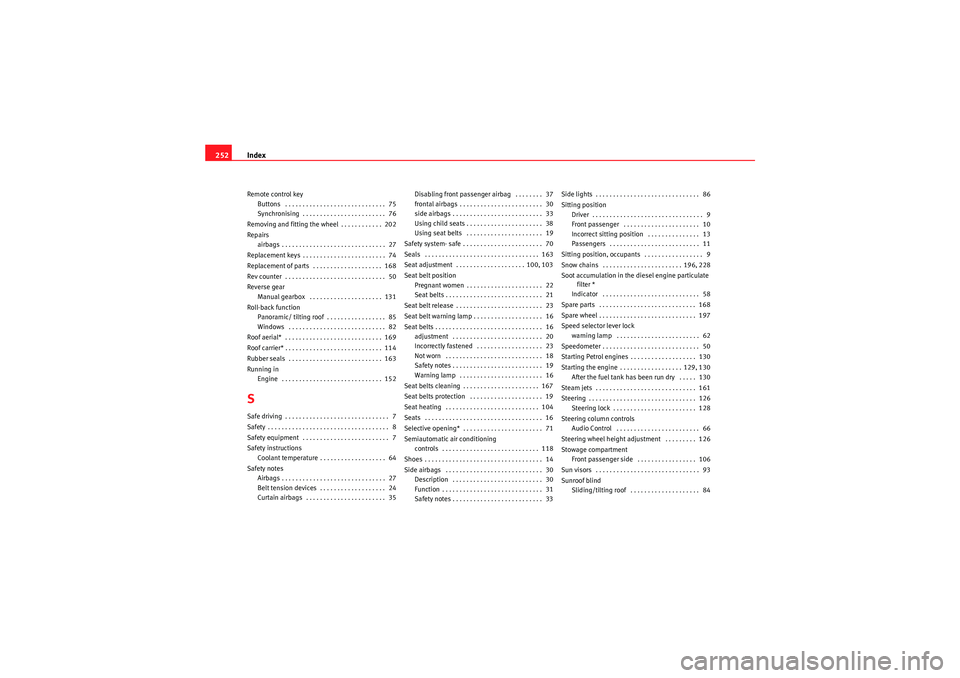2009 Seat Ibiza SC height adjustment
[x] Cancel search: height adjustmentPage 14 of 257

Safe driving
12Correct adjustment of head restraints
Properly adjusted head restraints are an important part of
passengers protection and can reduce the risk of injuries in
most accident situations.
Adjust the head restraint properly in order to achieve maximum
protection.
– Adjust the head restraint so that the top is at the same level as
the top of your head or as close as possible to the same level as
the top of your head, at least at eye level ⇒fig. 3 and ⇒ fig. 4.Adjusting the head restraints ⇒page 101.
WARNING
•Travelling with the head restraints removed or improperly adjusted
increases the risk of severe injuries.•Incorrectly adjusted head restraints could result in death in the event of
a collision or accident.•Incorrectly adjusted head restraints also increase the risk of injury
during sudden or unexpected driving or braking manoeuvres.•The head restraints must always be adjusted according to the
passenger's height.
Fig. 3 Properly adjusted
head restraint viewed
from the frontFig. 4 Properly adjusted
head restraint viewed
from the side
IbizaSC_EN.book Seite 12 Mittwoch, 16. September 2009 12:11 12
Page 41 of 257

Child safety39
Safety First
Controls and equipment
Practical tips
Technical Data
“Deactivating airbags*”. If the passenger seat has a height adjustment
option, move it to the highest position.
•For those vehicles that do not include a key lock switch to turn the
airbag off, an Authorised Service Centre must be consulted.•All passengers, especially children, must assume the proper sitting
position and be properly belted in while travelling.•Never hold children or babies on your lap, this can result in potentially
fatal injuries to the child!•Never allow a child to be transported in a vehicle without being properly
secured, or to stand up or kneel on a seat while travelling. In an accident,
the child could be flung through the vehicle, causing possibly fatal injuries
to themselves and to the other passengers.•If children assume an improper sitting position when the car is moving,
they expose themselves to greater risk of injury in the event of sudden
braking manoeuvre or in an accident. This is particularly important if the
child is travelling on the front passenger seat and the airbag system is trig-
gered in an accident, as this could cause serious injury or even death.•A suitable child seat can protect your child!•Never leave an unsupervised child alone on a child seat or in the
vehicle.•Depending on weather conditions, it may become extremely hot or cold
inside the vehicle. This can be fatal.•Children who are less than 1.5 metres tall must not wear a normal seat
belt without a child restraint system, as this could cause injuries to the
abdominal and neck areas during a sudden braking manoeuvre or in an
accident.•Do not allow the belt webbing to become twisted or jammed, or to rub
on any sharp edges.•Incorrectly worn seat belts can cause injuries even in a minor collision
or in sudden braking manoeuvres.
•The seat belt provides maximum protection only when the belt web is
properly positioned ⇒page 20, “Seat belts”.•Only one child may occupy a child seat ⇒page 40, “Child seats”.
WARNING (continued)
WARNING (continued)
IbizaSC_EN.book Seite 39 Mittwoch, 16. September 2009 12:11 12
Page 103 of 257

Seats and stowage101
Safety First
Controls and equipment
Practical tips
Technical Data
Head restraintsCorrect adjustment of head restraints
Properly adjusted head restraints are an important part of
passengers protection and can reduce the risk of injuries in
most accident situations.
– Adjust the head restraint so that the top is at the same level as
the top of your head or as close as possible to the same level as
the top of your head, at least at eye level ⇒fig. 65 and ⇒ fig. 66.Adjusting the head restraints ⇒page 102.
WARNING
•Travelling with the head restraints removed or improperly adjusted
increases the risk of severe injuries.•Improperly adjusted head restraints could lead to death in the event of
a collision or accident.•Incorrectly adjusted head restraints also increase the risk of injury
during sudden or unexpected driving or braking manoeuvres.•The head restraints must always be adjusted according to the
passenger's height.
Fig. 65 Front view: head
restraints and seat belts
correctly adjusted
Fig. 66 Side view: head
restraints and seat belts
correctly adjusted
IbizaSC_EN.book Seite 101 Mittwoch, 16. September 2009 12:11 12
Page 104 of 257

Seats and stowage
102Removing or adjusting head restraints
The head restraints can be adjusted by moving them up and
down.Adjusting height (front seats)
– Press the button on the side and pull upwards to the desired
position.
– To lower the head restraint, press the button and push head restraint downwards.
– Make sure that it engages securely into position.
Adjusting height (rear seats)
– Press the button on the side and pull upwards to the desired position. – To lower the head restraint, press the button and push head
restraint downwards.
– Make sure that the head restraint engages securely in one of its positions ⇒page 13.
Removing the head restraint
– Push the head restraint up as far as it will go.
–Press the button ⇒ fig. 67 (arrow).
– Pull head restraint out of fitting without releasing the button.
Fitting the head restraint
– Insert the head restraint into the guides on the rear backrest.
– Push head restraint down.
– Adjust the head rest to suit passenger's height ⇒page 12.
WARNING
•Never drive if the head restraints have been removed. Risk of injury.•Never drive if the head restraints are in an unsuitable position, there is
a risk of serious injury.•After refitting the head restraint, you must always adjust it properly for
height to achieve optimal protection.•Please observe the safety warnings ⇒page 101, “Correct adjustment
of head restraints”.Note
•To fit and remove the rear head restraints, gently tilt the seat backrest
forwards.
Fig. 67 Adjusting and
removing the head
restraints
IbizaSC_EN.book Seite 102 Mittwoch, 16. September 2009 12:11 12
Page 105 of 257

Seats and stowage103
Safety First
Controls and equipment
Practical tips
Technical Data
•When fitting the head restraints again, insert the tubes as far as possible
into the guides without pressing the button. Front seatsAdjustment of the front seats Adjusting the seat forwards and backwards
– Pull up the grip and move the seat forwards or backwards.
– Then release the grip and move the seat further until the catch engages.
Adjusting seat height
– Pull the lever up or push down (several times if necessary) from its home position. This adjust s the seat height in stages. Adjusting the backrest angle
– Take your weight off the backrest and turn the hand wheel.
To fold and unfold the seat back* (for two-door vehicles without
the Easy - Entry* function)
–To fold the seat back down, pull the lever upwards, in the
direction of the arrow and push the seat back forwards.
–To unfold the seatback, push it back.
Folding and unfolding the seat back* (for two-door vehicles
without the Easy - Entry* function)
–To fold the seat back down, pull the lever upwards, in the
direction of the arrow and push the seat back forwards. You can
push the seat forwards at the same time to make entry to the rear
seats easier.
–To unfold the seat back, first move the seat completely back.
The Easy-Entry function facilitates the access to the vehicle rear seats. Before
lifting the seat back, return the seat to the original position. The seat inserts
when the seat back is lifted.
WARNING
•Never adjust the driver or front passenger seat while the vehicle is in
motion. While adjusting your seat, you will assume an incorrect sitting
position. Risk of fatal accidents. Adjust the driver or front passenger seat
only when the vehicle is stationary.•To reduce the risk of injury to the driver and front passenger in case of
a sudden braking or an accident, ne ver drive with the backrest tilted
towards the rear. The maximum protection of the seat belt can be achieved
only when the backrests are in an upright position and the driver and front
Fig. 68 Front left seat
controls
A1
A1
A2
A3A4
A1
A4
A1
IbizaSC_EN.book Seite 103 Mittwoch, 16. September 2009 12:11 12
Page 128 of 257

Driving
126DrivingAddressAdjusting the steering wheel position
The height and reach of the steering wheel can be freely
adjusted to suit the driver.– Adjust the driver seat to the correct position.
– Push the lever under the steering column ⇒fig. 92 down ⇒.
– Adjust the steering wheel until the correct position is set ⇒fig. 92 .
– Then push the lever up again firmly ⇒.
WARNING
•Incorrect use of the steering column adjustment function and an incor-
rect seating position can result in serious injury.•To avoid accidents, the steering column should be adjusted only when
the vehicle is stationary.•Adjust the driver seat or steering wheel so that there is a distance of at
least 25 cm between the steering wheel and your chest ⇒fig. 92 . If you fail
to observe the minimum distance, the airbag will not protect you. Risk of
fatal injury.•If your physical constitution does not allow you to maintain the
minimum distance of 25 cm, contact an Authorised Service Centre. The
Authorised Service Centre will help you to decide if special specific modifi-
cations are necessary.•If you adjust the steering wheel so that it points towards your face, the
driver airbag will not protect you properly in the event of an accident. Make
sure that the steering wheel points towards your chest.•When driving, always hold the steering wheel with both hands on the
outside of the ring at the 9 o'clock and 3 o'clock positions. Never hold the
steering wheel at the 12 o'clock position, or in any other manner (e.g. in
the centre of the steering wheel, or on the inside of the rim). In such cases,
you could receive severe injuries to the arms, hands and head.
Fig. 92 Steering column
height adjustment
IbizaSC_EN.book Seite 126 Mittwoch, 16. September 2009 12:11 12
Page 254 of 257

Index
252Remote control key
Buttons . . . . . . . . . . . . . . . . . . . . . . . . . . . . . 75
Synchronising . . . . . . . . . . . . . . . . . . . . . . . . 76
Removing and fitting the wheel . . . . . . . . . . . . 202
Repairs airbags . . . . . . . . . . . . . . . . . . . . . . . . . . . . . . 27
Replacement keys . . . . . . . . . . . . . . . . . . . . . . . . 74
Replacement of parts . . . . . . . . . . . . . . . . . . . . 168
Rev counter . . . . . . . . . . . . . . . . . . . . . . . . . . . . . 50
Reverse gear Manual gearbox . . . . . . . . . . . . . . . . . . . . . 131
Roll-back function Panoramic/ tilting roof . . . . . . . . . . . . . . . . . 85
Windows . . . . . . . . . . . . . . . . . . . . . . . . . . . . 82
Roof aerial* . . . . . . . . . . . . . . . . . . . . . . . . . . . . 169
Roof carrier* . . . . . . . . . . . . . . . . . . . . . . . . . . . . 114
Rubber seals . . . . . . . . . . . . . . . . . . . . . . . . . . . 163
Running in Engine . . . . . . . . . . . . . . . . . . . . . . . . . . . . . 152SSafe driving . . . . . . . . . . . . . . . . . . . . . . . . . . . . . . 7
Safety . . . . . . . . . . . . . . . . . . . . . . . . . . . . . . . . . . . 8
Safety equipment . . . . . . . . . . . . . . . . . . . . . . . . . 7
Safety instructions
Coolant temperature . . . . . . . . . . . . . . . . . . . 64
Safety notes Airbags . . . . . . . . . . . . . . . . . . . . . . . . . . . . . . 27
Belt tension devices . . . . . . . . . . . . . . . . . . . 24
Curtain airbags . . . . . . . . . . . . . . . . . . . . . . . 35 Disabling front passenger airbag . . . . . . . . 37
frontal airbags . . . . . . . . . . . . . . . . . . . . . . . . 30
side airbags . . . . . . . . . . . . . . . . . . . . . . . . . . 33
Using child seats . . . . . . . . . . . . . . . . . . . . . . 38
Using seat belts . . . . . . . . . . . . . . . . . . . . . . 19
Safety system- safe . . . . . . . . . . . . . . . . . . . . . . . 70
Seals . . . . . . . . . . . . . . . . . . . . . . . . . . . . . . . . . 163
Seat adjustment . . . . . . . . . . . . . . . . . . . . 100, 103
Seat belt position Pregnant women . . . . . . . . . . . . . . . . . . . . . . 22
Seat belts . . . . . . . . . . . . . . . . . . . . . . . . . . . . 21
Seat belt release . . . . . . . . . . . . . . . . . . . . . . . . . 23
Seat belt warning lamp . . . . . . . . . . . . . . . . . . . . 16
Seat belts . . . . . . . . . . . . . . . . . . . . . . . . . . . . . . . 16 adjustment . . . . . . . . . . . . . . . . . . . . . . . . . . 20
Incorrectly fastened . . . . . . . . . . . . . . . . . . . 23
Not worn . . . . . . . . . . . . . . . . . . . . . . . . . . . . 18
Safety notes . . . . . . . . . . . . . . . . . . . . . . . . . . 19
Warning lamp . . . . . . . . . . . . . . . . . . . . . . . . 16
Seat belts cleaning . . . . . . . . . . . . . . . . . . . . . . 167
Seat belts protection . . . . . . . . . . . . . . . . . . . . . 19
Seat heating . . . . . . . . . . . . . . . . . . . . . . . . . . . 104
Seats . . . . . . . . . . . . . . . . . . . . . . . . . . . . . . . . . . 16
Selective opening* . . . . . . . . . . . . . . . . . . . . . . . 71
Semiautomatic air conditioning controls . . . . . . . . . . . . . . . . . . . . . . . . . . . . 118
Shoes . . . . . . . . . . . . . . . . . . . . . . . . . . . . . . . . . . 14
Side airbags . . . . . . . . . . . . . . . . . . . . . . . . . . . . 30 Description . . . . . . . . . . . . . . . . . . . . . . . . . . 30
Function . . . . . . . . . . . . . . . . . . . . . . . . . . . . . 31
Safety notes . . . . . . . . . . . . . . . . . . . . . . . . . . 33 Side lights . . . . . . . . . . . . . . . . . . . . . . . . . . . . . . 86
Sitting position
Driver . . . . . . . . . . . . . . . . . . . . . . . . . . . . . . . . 9
Front passenger . . . . . . . . . . . . . . . . . . . . . . 10
Incorrect sitting position . . . . . . . . . . . . . . . 13
Passengers . . . . . . . . . . . . . . . . . . . . . . . . . . 11
Sitting position, occupants . . . . . . . . . . . . . . . . . 9
Snow chains . . . . . . . . . . . . . . . . . . . . . . . 196, 228
Soot accumulation in the diesel engine particulate filter *
Indicator . . . . . . . . . . . . . . . . . . . . . . . . . . . . 58
Spare parts . . . . . . . . . . . . . . . . . . . . . . . . . . . . 168
Spare wheel . . . . . . . . . . . . . . . . . . . . . . . . . . . . 197
Speed selector lever lock warning lamp . . . . . . . . . . . . . . . . . . . . . . . . 62
Speedometer . . . . . . . . . . . . . . . . . . . . . . . . . . . . 50
Starting Petrol engines . . . . . . . . . . . . . . . . . . . 130
Starting the engine . . . . . . . . . . . . . . . . . . 129, 130 After the fuel tank has been run dry . . . . . 130
Steam jets . . . . . . . . . . . . . . . . . . . . . . . . . . . . . 161
Steering . . . . . . . . . . . . . . . . . . . . . . . . . . . . . . . 126 Steering lock . . . . . . . . . . . . . . . . . . . . . . . . 128
Steering column controls Audio Control . . . . . . . . . . . . . . . . . . . . . . . . 66
Steering wheel height adjustment . . . . . . . . . 126
Stowage compartment Front passenger side . . . . . . . . . . . . . . . . . 106
Sun visors . . . . . . . . . . . . . . . . . . . . . . . . . . . . . . 93
Sunroof blind Sliding/tilting roof . . . . . . . . . . . . . . . . . . . . 84
IbizaSC_EN.book Seite 252 Mittwoch, 16. September 2009 12:11 12